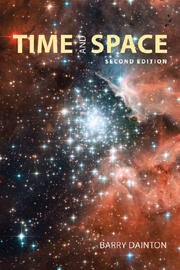Book contents
- Frontmatter
- Contents
- Preface to the second edition
- Preface to the first edition
- 1 Preliminaries
- 2 McTaggart on time's unreality
- 3 The Block universe
- 4 Asymmetries within time
- 5 Tensed time
- 6 Dynamic time
- 7 Time and consciousness
- 8 Time travel
- 9 Conceptions of void
- 10 Space: the classical debate
- 11 Absolute motion
- 12 Motion in spacetime
- 13 Curved space
- 14 Tangible space
- 15 Spatial anti-realism
- 16 Zeno and the continuum I
- 17 Zeno and the continuum II
- 18 Special relativity
- 19 Relativity and reality
- 20 General relativity
- 21 Spacetime metaphysics
- 22 Strings
- Notes
- Glossary
- Web resources
- Bibliography
- Index
11 - Absolute motion
- Frontmatter
- Contents
- Preface to the second edition
- Preface to the first edition
- 1 Preliminaries
- 2 McTaggart on time's unreality
- 3 The Block universe
- 4 Asymmetries within time
- 5 Tensed time
- 6 Dynamic time
- 7 Time and consciousness
- 8 Time travel
- 9 Conceptions of void
- 10 Space: the classical debate
- 11 Absolute motion
- 12 Motion in spacetime
- 13 Curved space
- 14 Tangible space
- 15 Spatial anti-realism
- 16 Zeno and the continuum I
- 17 Zeno and the continuum II
- 18 Special relativity
- 19 Relativity and reality
- 20 General relativity
- 21 Spacetime metaphysics
- 22 Strings
- Notes
- Glossary
- Web resources
- Bibliography
- Index
Summary
Inertial motion
Newton deploys two basic arguments against relationism. The best known is the argument from inertial effects: the notorious bucket argument. The second is the argument for real inertial motion. Both are connected with Newton's first law of motion, namely that any object will continue to move at a constant velocity (or remain at rest) unless acted on by a force. Before proceeding it will help to review some of the relevant terminology.
As we have already seen, Newton's first law is often called the “law of inertia”. Inertial motion is motion in the absence of impinging forces: a moving body will continue to move at the same speed in a straight line for ever if no forces act on it. Inertial forces are the forces experienced by a body that is undergoing acceleration.
We already know that in the context of Newton's physics a body is at absolute rest if it is stationary with respect to absolute space, and in absolute motion if is moving relative to absolute space. An object possesses relative velocity if it is moving at a certain speed and direction with respect to another object. Accelera tion is rate of change of velocity. So an object is undergoing absolute acceleration when it is changing its velocity with respect to absolute space, whereas relative acceleration consists in a change in velocity with respect to some other bodies.
Information
- Type
- Chapter
- Information
- Time and Space , pp. 182 - 193Publisher: Acumen PublishingPrint publication year: 2010
